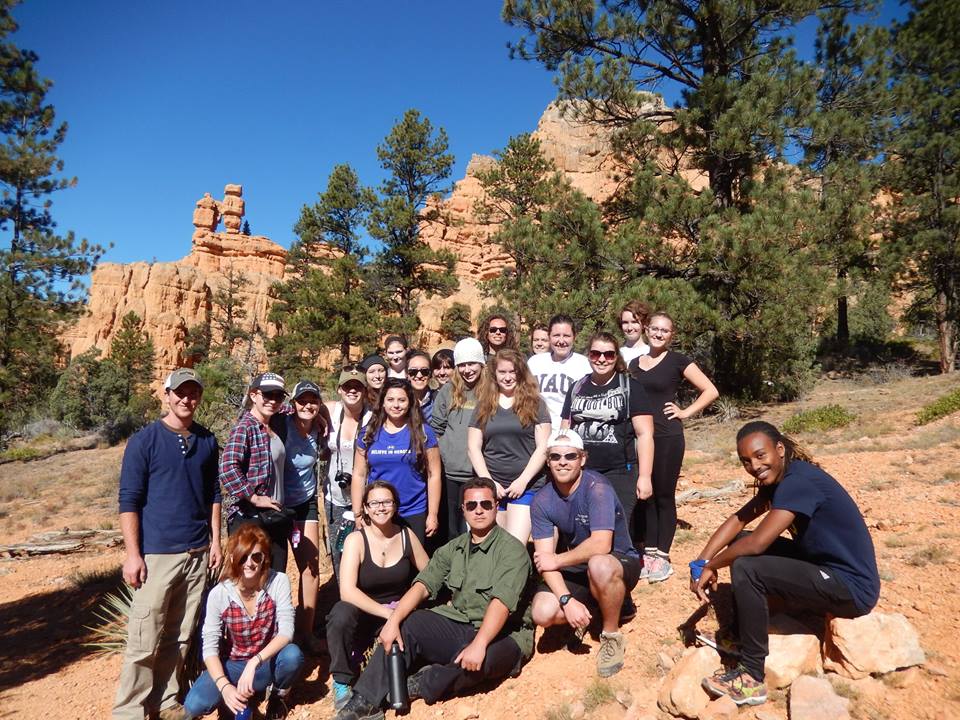Students who want to explore the full landscape of learning are discovering that Northern Arizona University enjoys a distinct natural advantage. And through the student organization TravelEd, they are pitching their tent on the side of outdoor experience.
Admittedly, some pitch a little better than others.
Still, what began as an optional class activity offered by Britton Shepardson, lecturer and associate chair of anthropology, has grown into a student-run operation that continues to attract new members.
“I think it’s important for these students to realize how many spectacular sites are within a five-hour drive of NAU,” said Shepardson, who serves as an academic guide on the day trips and overnight camping excursions. “For me, the best-case scenario is to have a student who is willing to try something new and different, and put their trust in me and the students around them to get through it the first time. A lot of them have literally never set up a tent before.”
“The trips are something new every time,” Shepardson said. “But they’re always awesome.”
Day trips have involved up to 35 students traveling to Montezuma’s Well, Montezuma’s Castle, Tuzigoot, the Petrified Forest, Picture Canyon, Wupatki and Rock Art Ranch. Weekend camping trips, which involve smaller groups, have taken students to Canyon de Chelly, Chaco Canyon, Mesa Verde and Bryce Canyon. Next on their list for spring 2016 is Bandelier National Monument, N.M.
“These students carpool and pay their own way, and their only real incentive is to go learn about and appreciate these places firsthand,” Shepardson said.
Shepardson began coordinating the trips as a part-time instructor of Anthropology 104 when he was first starting at NAU. Some of the students were so inspired, they decided to form an ASNAU-sanctioned club.
Kaitlyn Jebens, a third-year anthropology major, is the treasurer of TravelEd. Madison Ledesma, also a third-year anthropology major, is public relations officer. Inspired by their own experience during their freshman year, they worked with other participants to write a constitution and last spring navigated the formal approval process for a student organization.
“We took Anthro 104 and went to Chaco Canyon, and we liked it so much we wanted to do more,” Jebens said. “It’s cool because I can form my own visual of these places and see how ideas apply from my classes.”
On the trip to Bryce Canyon, Jebens said the group stayed at Kodachrome State Park as a strategy to avoid the crowded national parks, which often require reservations months ahead of time.
“We were almost the only people there,” Jebens said. “It was beautiful.”
There are about 25 students in the club, which requires only a $5 fee per semester—and is free for those enrolled in Anthropology 104 with Shepardson. Students must go on a day trip before they can participate in an overnight one. About half the equipment used on a trip is personal, and the rest is rented, often from Campus Recreation Outdoor Adventures in NAU’s Health and Learning Center.
The club’s officers agreed that despite the lack of outdoors experience among some of the members—noting that a student on one trip didn’t think he would need a tent or even a sleeping bag—plenty of teamwork is displayed in planning the trips and setting up camp.
“We’re trying to meet once a week or so to locate new sites and plan trips,” Ledesma said. “We want to get more students involved in the process.”
Shepardson said it’s his vision that with so many world-class parks and forests nearby, the camping trips might inspire the next generation of citizens to advocate for conservation. “The students latch on to the experience,” he said. “Being out there creates a real connection with the place and a feeling of responsibility.”



